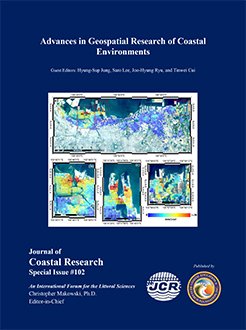Wei, Y.; Zhang, Z.; Mu, B.; Li, Y.; Wang, Q., and Liu, R., 2020. Geolocation accuracy evaluation of GF-4 geostationary high-resolution optical images over coastal zones and offshore areas. In: Jung, H.-S.; Lee, S.; Ryu, J.H., and Cui, T. (eds.), Advances in Geospatial Research of Coastal Environments. Journal of Coastal Research, Special Issue No. 102, pp. 326-333. Coconut Creek (Florida), ISSN 0749-0208.
GF-4 is the first high-resolution geostationary satellite launched by China in 2015 for disaster prevention and mitigation. It can provide high spatial (up to 50 m) and temporal resolution optical images. Autonomous geolocation accuracy is key for the application of satellite images, particularly for coastal zones, offshore areas, and even oceans with few ground control points (GCPs). Hence, this study characterizes the autonomous geometric accuracy of GF-4 panchromatic and multispectral sensor images over coastal zones and offshore areas, which is of particular importance for the monitoring of moving targets. The evaluation of nine GF-4 images based on 630 GCPs in coastal zones and offshore areas of the Bohai Sea and Yellow Sea indicates a geolocation uncertainty of 1925 ± 976 m (39 ± 20 pixels). For GF-4 images with similar imaging geometry, the geolocation discrepancy is lower than that with different imaging geometry, with the geolocation discrepancy of 1 ± 1 and 30 ± 13 pixels, respectively. Although with the lower geolocation discrepancy, noticeable uncertainty occurs in the estimated velocity of moving targets for images with similar imaging geometry, particularly for low-speed targets, such as macro-algae. This suggests that geometric correction is needed before the speed of the moving target is extracted. The geolocation accuracy of GF-4 images through rational polynomial coefficient orthorectification without GCPs is also poor, with the geolocation uncertainty of 1350 ± 864 m, whereas the geolocation accuracy significantly improved by 8.2 times after five GCPs were added (distributed in the four corners and center of the image).





